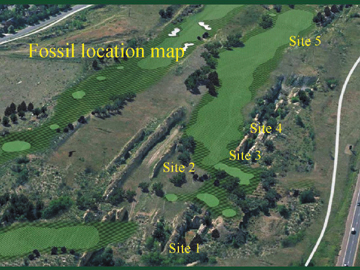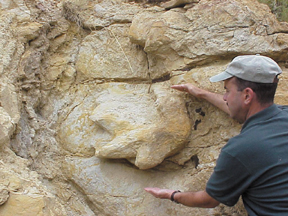

A series of clay pits most recently used as a landfill in Golden, Colo. are being turned into an 18-hole golf course. While this is not an unusual way to put such land to use, golfers on this course will tee off among Triceratops tracks and fern fossils as part of a unique land-use compromise. Opponents of the plan criticize the city of Golden for not turning the area into a public site showcasing the ancient impressions.
“The fossils won’t be accessible to 100 percent of the public 100 percent of the time,” says Dan Hartman, Golden’s Public Works director. “But we think this is a pretty good compromise.”

[Right: A conception of the proposed golf course in Golden, Colo., showing the location of fossil sites.]
The 65 million-year old tracks and impressions were found in vertically tilted sandstone beds lying between layers of clay on land owned by the Parfet family. As the “Parfet pits” were mined for refractory grade clay, the exposed fossils drew the attention of paleontologists and amateur fossil hunters. Five fossil sites containing Triceratops, theropod and hadrosaur tracks, as well as impressions of leaves and palm fronds, were identified in the pits.
The pits were used as landfill for a coal-burning byproduct called fly ash. Fly ash could leach out heavy metals, Hartman explains, making the area potentially hazardous. So, when Chip Parfet donated the land to Golden, he did so with the condition that the ash would be consolidated and the pits capped — at a cost of $1.5 million. He also stipulated that the area be made into a golf course. Homes or buildings with deep foundations could not be built on the pits because such construction would breach the cap, Hartman says. A golf course, on the other hand, requires only superficial construction.
The city of Golden hired Martin Lockley, a geologist from the University of Colorado at Denver, to identify the fossils at the five sites and to advise the City Council on what to do with them. Lockley has studied the fossils since 1988. In the plan he devised with the city, one dinosaur footprint will be removed and displayed in the golf course clubhouse, tracks at two sites will remain exposed in situ, one set of dinosaur footprints will be reburied, and a 20-foot wall with palm fronds and two rare Triceratops tracks will be left undisturbed. According to Hartman, the palm frond site has the most “tourist value,” and the course’s 12th hole green and golf cart path were relocated to accommodate it. Access trails and signs will be added to all preserved sites, and the city will make them available to the public “as often as we can,” he says.
But this is not enough for those who want year-round access to the fossils without having to pay to tee off first.
“The fossils on that wall belong to the state of Colorado,” says William T. Caneer, a retired geologist and former director of the nearby Dinosaur Ridge National Natural Landmark. “The response that I am getting from people in Colorado, Golden and across the land is that it is necessary to have unrestricted access.”

[Left: A dinosaur track at Site 3 will be incorporated into the golf course.]
Caneer, who has lived in Golden for 34 years, led fellow residents in protests against the course’s construction and currently advocates that the city make the palm frond and dinosaur track site permanently open to the general public. The fossils in the vertical bed face away from the fairway, so he doesn’t see a conflict between an accessible, public viewing site and the golfers’ games. Much like Dinosaur Ridge, such a site would allow people to view the footprints and fronds in situ, “so they can walk along the same ground as did the dinosaurs,” he says.
Construction on the golf course is currently underway, with building affecting two of the sites in late September to early October. “Caneer wants us not to build a golf course, but the money that allows us to preserve the fossils is the golf course money. Nobody goes home feeling like they got everything,” Hartman says.
Jann Vendetti
 |
Geotimes Home | AGI Home | Information Services | Geoscience Education | Public Policy | Programs | Publications | Careers |